Marketing Analysis of the Fashion Industry: Michael Kors Case Study
VerifiedAdded on 2023/04/17
|10
|2318
|129
Report
AI Summary
This report provides a comprehensive marketing analysis of the Michael Kors fashion industry. It begins with an introduction to the company and its marketing activities, followed by an examination of the factors impacting the fashion industry, including micro and macro environmental forces. The report then analyzes Michael Kors' value chain using Porter's model, detailing primary and support activities. An evaluation of the Indian market is presented, including the '12 Cs' of successful team building and market entry strategies such as exporting and joint ventures. The report also discusses the elements of the marketing mix (price, place, and promotion) in the context of the Indian and UK markets. The report concludes with a summary of the key findings and references.

Marketing
Paraphrase This Document
Need a fresh take? Get an instant paraphrase of this document with our AI Paraphraser
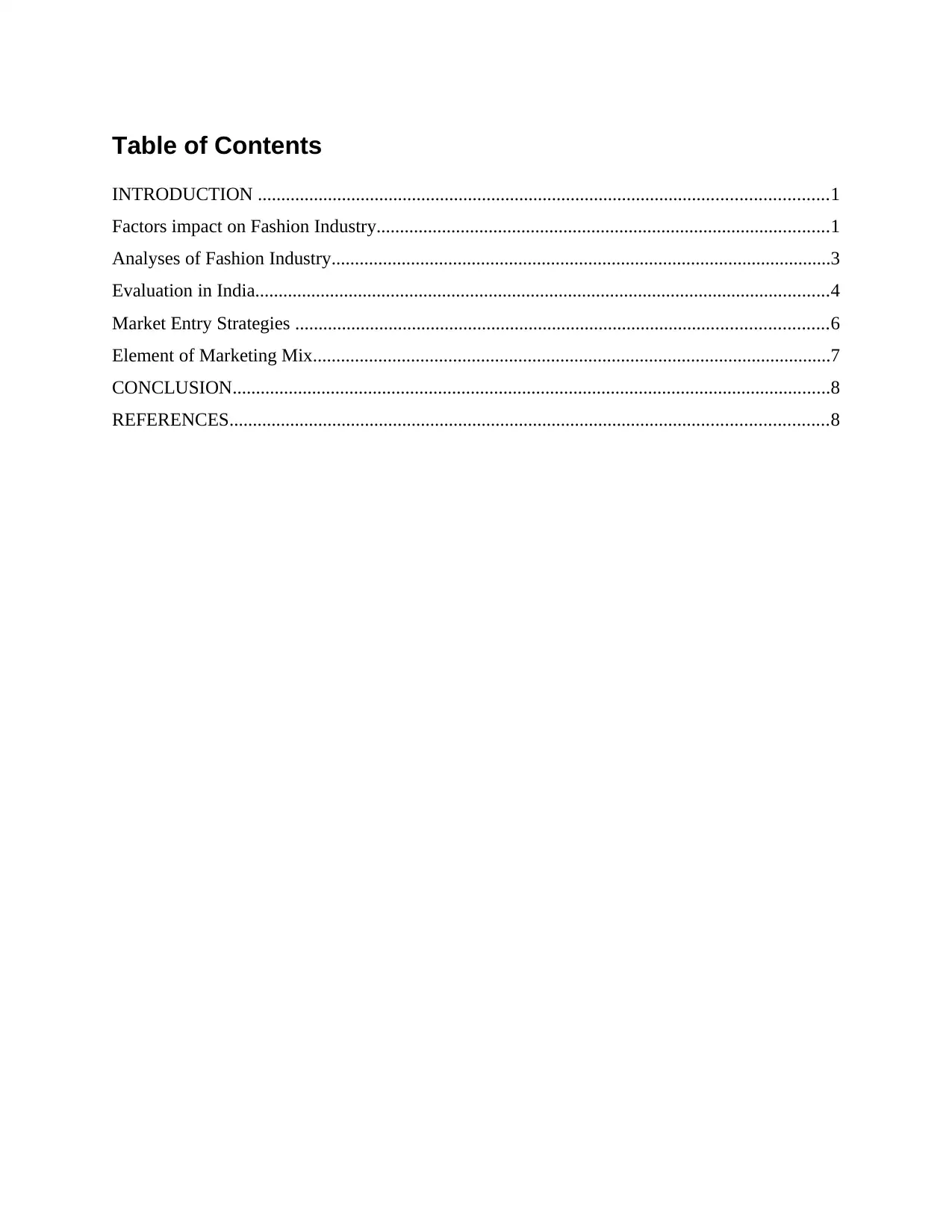
Table of Contents
INTRODUCTION ..........................................................................................................................1
Factors impact on Fashion Industry.................................................................................................1
Analyses of Fashion Industry...........................................................................................................3
Evaluation in India...........................................................................................................................4
Market Entry Strategies ..................................................................................................................6
Element of Marketing Mix...............................................................................................................7
CONCLUSION................................................................................................................................8
REFERENCES................................................................................................................................8
INTRODUCTION ..........................................................................................................................1
Factors impact on Fashion Industry.................................................................................................1
Analyses of Fashion Industry...........................................................................................................3
Evaluation in India...........................................................................................................................4
Market Entry Strategies ..................................................................................................................6
Element of Marketing Mix...............................................................................................................7
CONCLUSION................................................................................................................................8
REFERENCES................................................................................................................................8
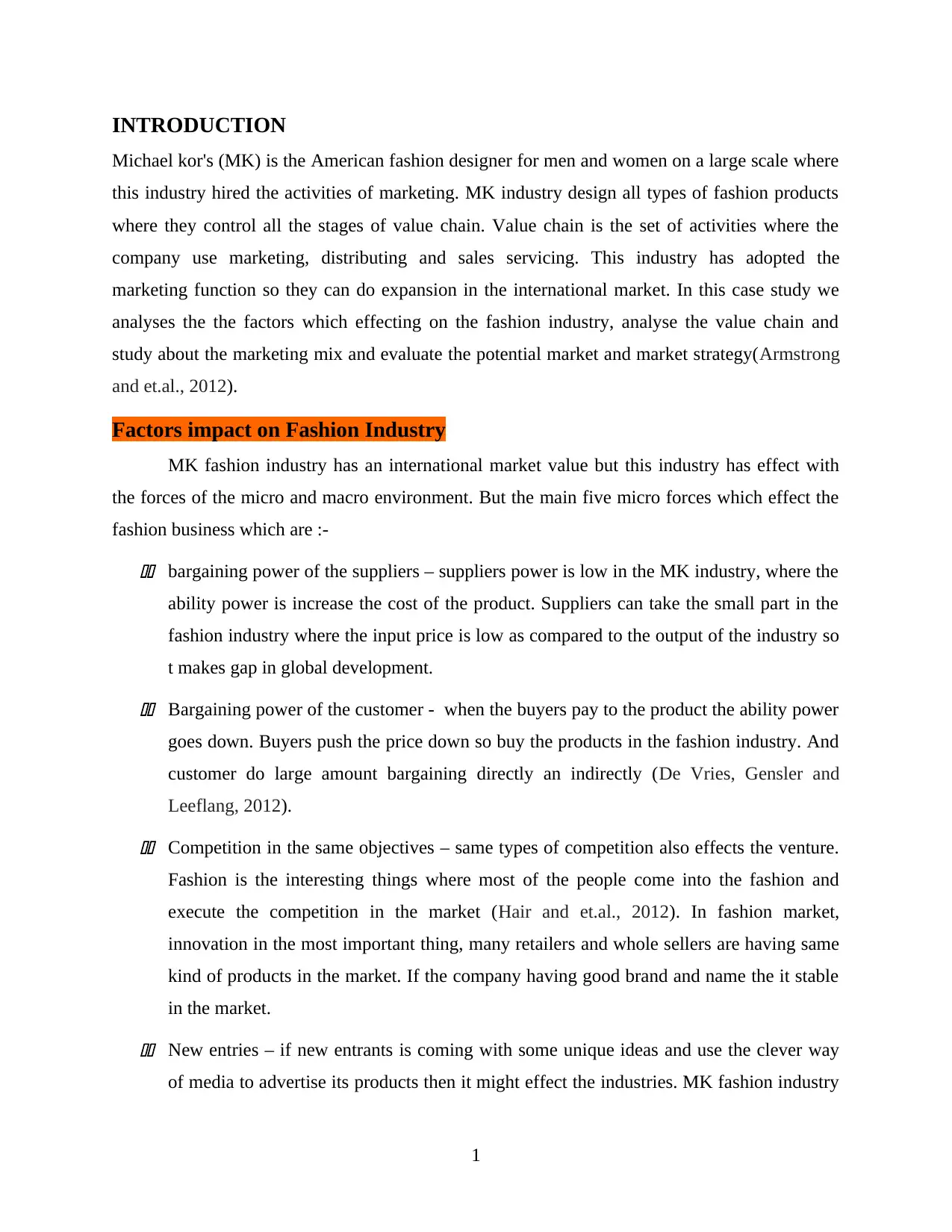
INTRODUCTION
Michael kor's (MK) is the American fashion designer for men and women on a large scale where
this industry hired the activities of marketing. MK industry design all types of fashion products
where they control all the stages of value chain. Value chain is the set of activities where the
company use marketing, distributing and sales servicing. This industry has adopted the
marketing function so they can do expansion in the international market. In this case study we
analyses the the factors which effecting on the fashion industry, analyse the value chain and
study about the marketing mix and evaluate the potential market and market strategy(Armstrong
and et.al., 2012).
Factors impact on Fashion Industry
MK fashion industry has an international market value but this industry has effect with
the forces of the micro and macro environment. But the main five micro forces which effect the
fashion business which are :-11 bargaining power of the suppliers – suppliers power is low in the MK industry, where the
ability power is increase the cost of the product. Suppliers can take the small part in the
fashion industry where the input price is low as compared to the output of the industry so
t makes gap in global development.11 Bargaining power of the customer - when the buyers pay to the product the ability power
goes down. Buyers push the price down so buy the products in the fashion industry. And
customer do large amount bargaining directly an indirectly (De Vries, Gensler and
Leeflang, 2012).11 Competition in the same objectives – same types of competition also effects the venture.
Fashion is the interesting things where most of the people come into the fashion and
execute the competition in the market (Hair and et.al., 2012). In fashion market,
innovation in the most important thing, many retailers and whole sellers are having same
kind of products in the market. If the company having good brand and name the it stable
in the market.11 New entries – if new entrants is coming with some unique ideas and use the clever way
of media to advertise its products then it might effect the industries. MK fashion industry
1
Michael kor's (MK) is the American fashion designer for men and women on a large scale where
this industry hired the activities of marketing. MK industry design all types of fashion products
where they control all the stages of value chain. Value chain is the set of activities where the
company use marketing, distributing and sales servicing. This industry has adopted the
marketing function so they can do expansion in the international market. In this case study we
analyses the the factors which effecting on the fashion industry, analyse the value chain and
study about the marketing mix and evaluate the potential market and market strategy(Armstrong
and et.al., 2012).
Factors impact on Fashion Industry
MK fashion industry has an international market value but this industry has effect with
the forces of the micro and macro environment. But the main five micro forces which effect the
fashion business which are :-11 bargaining power of the suppliers – suppliers power is low in the MK industry, where the
ability power is increase the cost of the product. Suppliers can take the small part in the
fashion industry where the input price is low as compared to the output of the industry so
t makes gap in global development.11 Bargaining power of the customer - when the buyers pay to the product the ability power
goes down. Buyers push the price down so buy the products in the fashion industry. And
customer do large amount bargaining directly an indirectly (De Vries, Gensler and
Leeflang, 2012).11 Competition in the same objectives – same types of competition also effects the venture.
Fashion is the interesting things where most of the people come into the fashion and
execute the competition in the market (Hair and et.al., 2012). In fashion market,
innovation in the most important thing, many retailers and whole sellers are having same
kind of products in the market. If the company having good brand and name the it stable
in the market.11 New entries – if new entrants is coming with some unique ideas and use the clever way
of media to advertise its products then it might effect the industries. MK fashion industry
1
⊘ This is a preview!⊘
Do you want full access?
Subscribe today to unlock all pages.

Trusted by 1+ million students worldwide
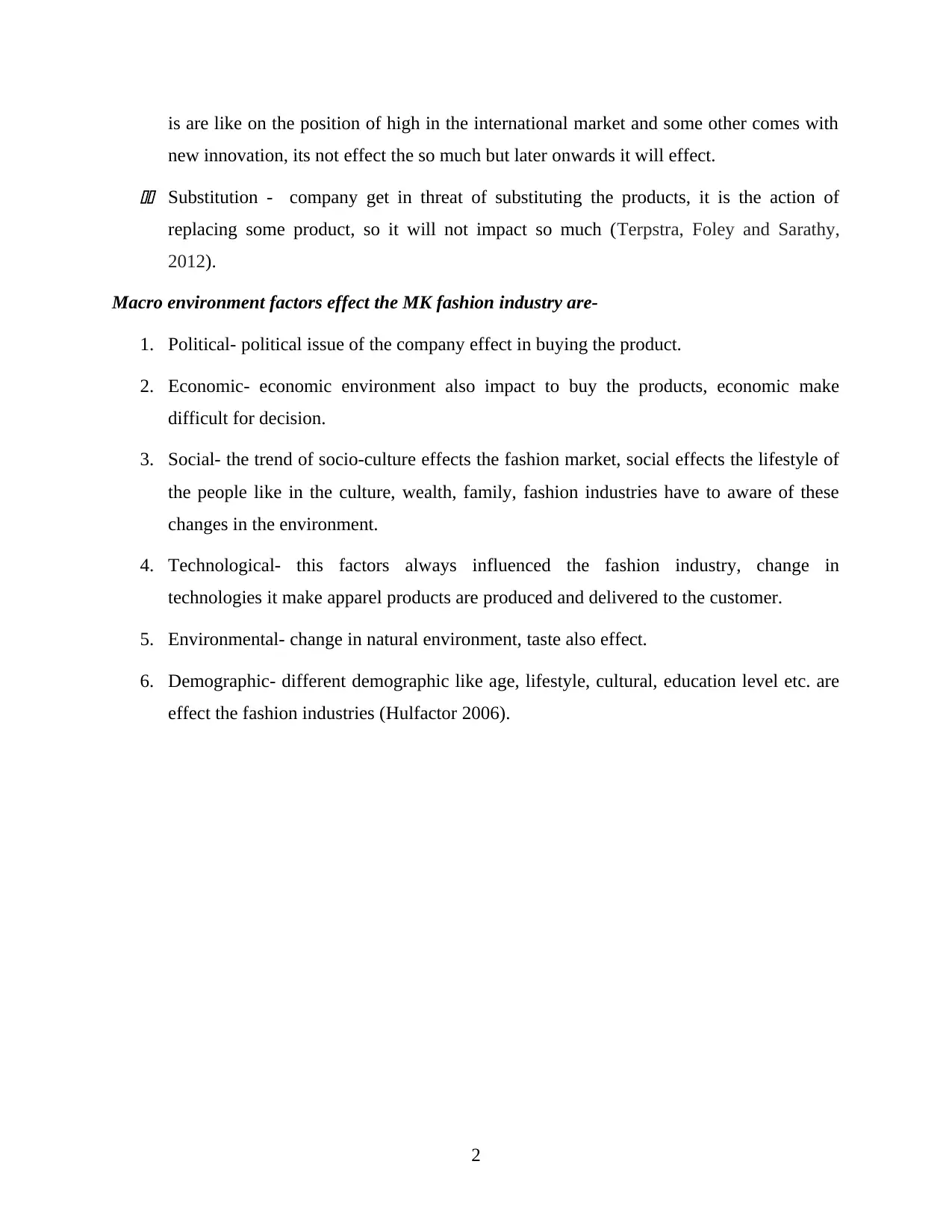
is are like on the position of high in the international market and some other comes with
new innovation, its not effect the so much but later onwards it will effect.11 Substitution - company get in threat of substituting the products, it is the action of
replacing some product, so it will not impact so much (Terpstra, Foley and Sarathy,
2012).
Macro environment factors effect the MK fashion industry are-
1. Political- political issue of the company effect in buying the product.
2. Economic- economic environment also impact to buy the products, economic make
difficult for decision.
3. Social- the trend of socio-culture effects the fashion market, social effects the lifestyle of
the people like in the culture, wealth, family, fashion industries have to aware of these
changes in the environment.
4. Technological- this factors always influenced the fashion industry, change in
technologies it make apparel products are produced and delivered to the customer.
5. Environmental- change in natural environment, taste also effect.
6. Demographic- different demographic like age, lifestyle, cultural, education level etc. are
effect the fashion industries (Hulfactor 2006).
2
new innovation, its not effect the so much but later onwards it will effect.11 Substitution - company get in threat of substituting the products, it is the action of
replacing some product, so it will not impact so much (Terpstra, Foley and Sarathy,
2012).
Macro environment factors effect the MK fashion industry are-
1. Political- political issue of the company effect in buying the product.
2. Economic- economic environment also impact to buy the products, economic make
difficult for decision.
3. Social- the trend of socio-culture effects the fashion market, social effects the lifestyle of
the people like in the culture, wealth, family, fashion industries have to aware of these
changes in the environment.
4. Technological- this factors always influenced the fashion industry, change in
technologies it make apparel products are produced and delivered to the customer.
5. Environmental- change in natural environment, taste also effect.
6. Demographic- different demographic like age, lifestyle, cultural, education level etc. are
effect the fashion industries (Hulfactor 2006).
2
Paraphrase This Document
Need a fresh take? Get an instant paraphrase of this document with our AI Paraphraser
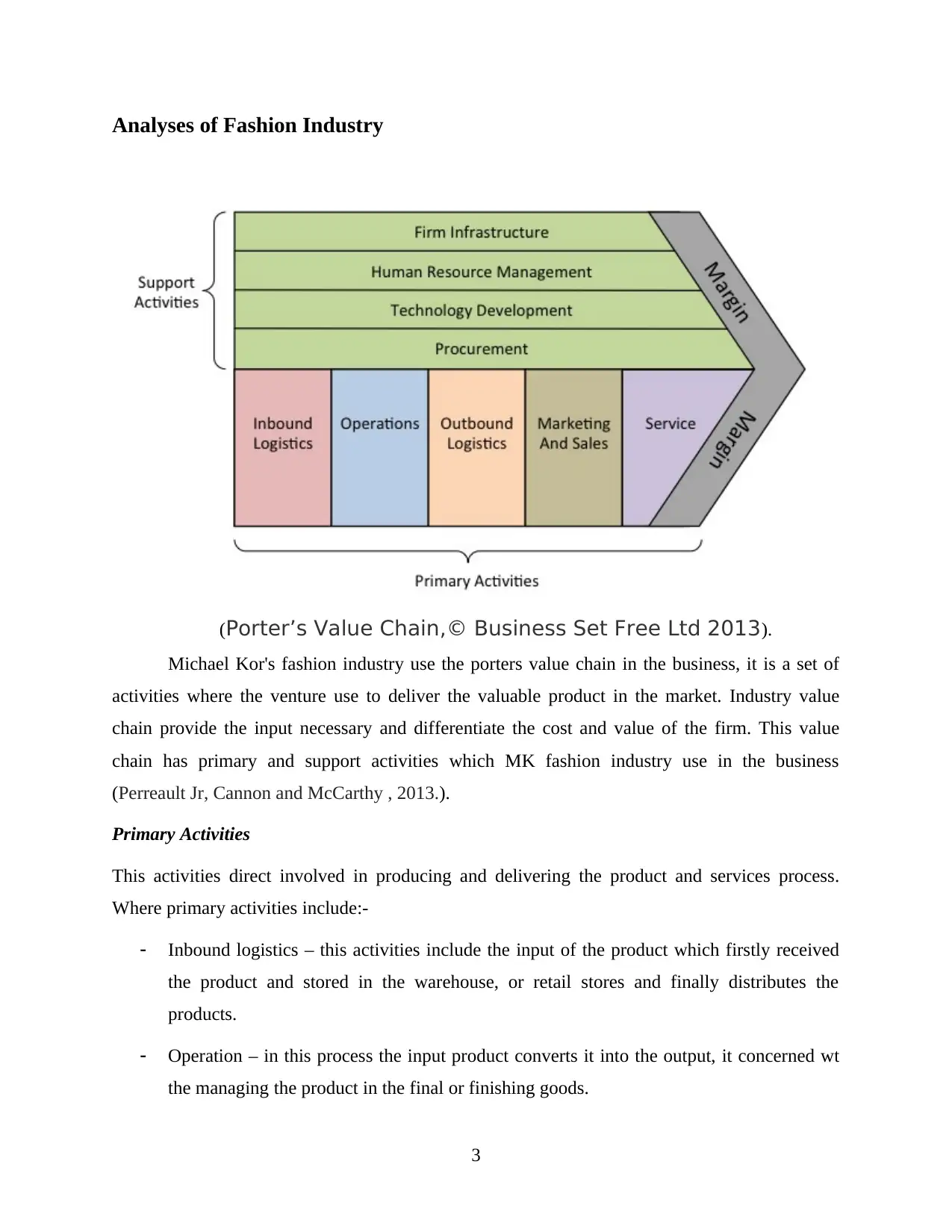
Analyses of Fashion Industry
(Porter’s Value Chain,© Business Set Free Ltd 2013).
Michael Kor's fashion industry use the porters value chain in the business, it is a set of
activities where the venture use to deliver the valuable product in the market. Industry value
chain provide the input necessary and differentiate the cost and value of the firm. This value
chain has primary and support activities which MK fashion industry use in the business
(Perreault Jr, Cannon and McCarthy , 2013.).
Primary Activities
This activities direct involved in producing and delivering the product and services process.
Where primary activities include:-
Inbound logistics – this activities include the input of the product which firstly received
the product and stored in the warehouse, or retail stores and finally distributes the
products.
Operation – in this process the input product converts it into the output, it concerned wt
the managing the product in the final or finishing goods.
3
(Porter’s Value Chain,© Business Set Free Ltd 2013).
Michael Kor's fashion industry use the porters value chain in the business, it is a set of
activities where the venture use to deliver the valuable product in the market. Industry value
chain provide the input necessary and differentiate the cost and value of the firm. This value
chain has primary and support activities which MK fashion industry use in the business
(Perreault Jr, Cannon and McCarthy , 2013.).
Primary Activities
This activities direct involved in producing and delivering the product and services process.
Where primary activities include:-
Inbound logistics – this activities include the input of the product which firstly received
the product and stored in the warehouse, or retail stores and finally distributes the
products.
Operation – in this process the input product converts it into the output, it concerned wt
the managing the product in the final or finishing goods.
3
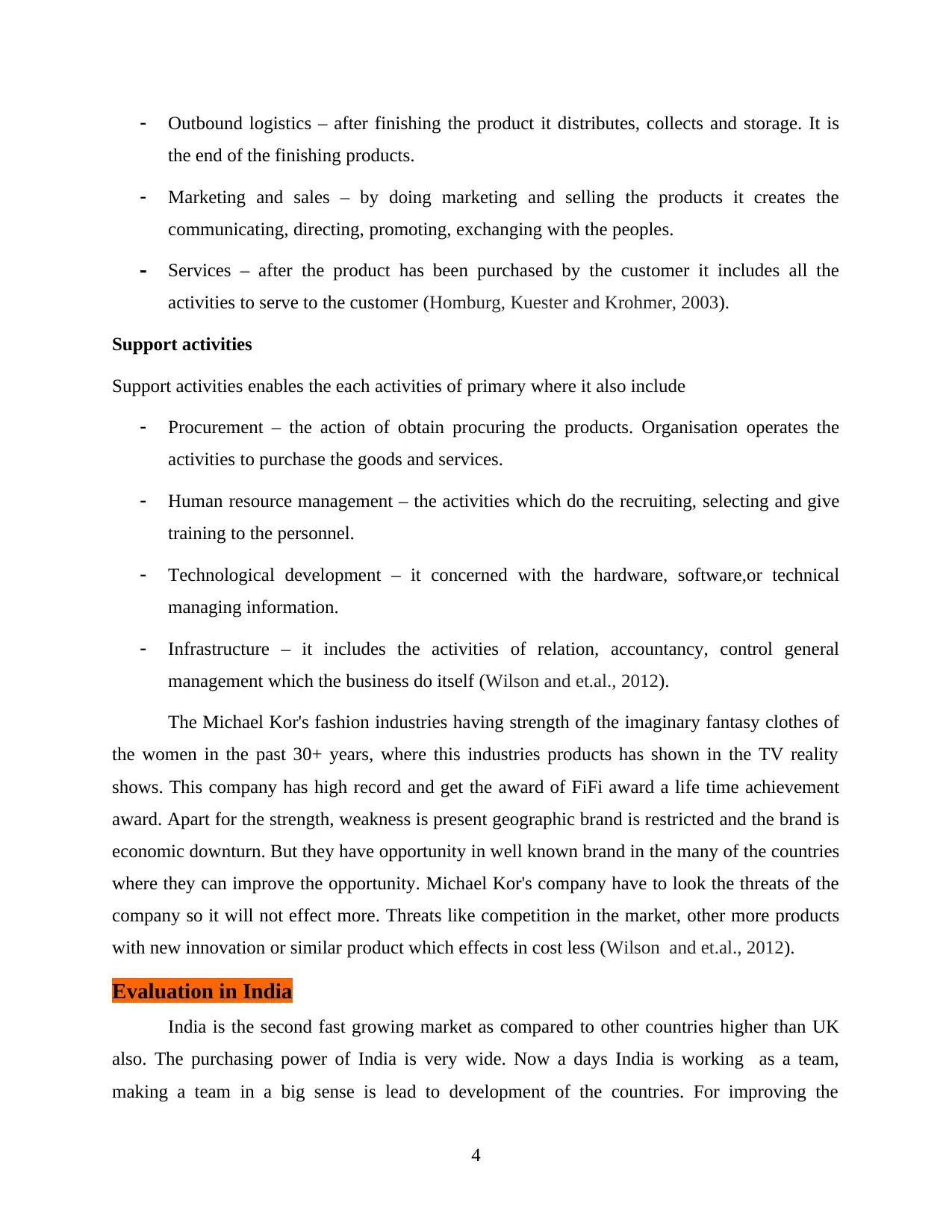
Outbound logistics – after finishing the product it distributes, collects and storage. It is
the end of the finishing products.
Marketing and sales – by doing marketing and selling the products it creates the
communicating, directing, promoting, exchanging with the peoples.
Services – after the product has been purchased by the customer it includes all the
activities to serve to the customer (Homburg, Kuester and Krohmer, 2003).
Support activities
Support activities enables the each activities of primary where it also include
Procurement – the action of obtain procuring the products. Organisation operates the
activities to purchase the goods and services.
Human resource management – the activities which do the recruiting, selecting and give
training to the personnel.
Technological development – it concerned with the hardware, software,or technical
managing information.
Infrastructure – it includes the activities of relation, accountancy, control general
management which the business do itself (Wilson and et.al., 2012).
The Michael Kor's fashion industries having strength of the imaginary fantasy clothes of
the women in the past 30+ years, where this industries products has shown in the TV reality
shows. This company has high record and get the award of FiFi award a life time achievement
award. Apart for the strength, weakness is present geographic brand is restricted and the brand is
economic downturn. But they have opportunity in well known brand in the many of the countries
where they can improve the opportunity. Michael Kor's company have to look the threats of the
company so it will not effect more. Threats like competition in the market, other more products
with new innovation or similar product which effects in cost less (Wilson and et.al., 2012).
Evaluation in India
India is the second fast growing market as compared to other countries higher than UK
also. The purchasing power of India is very wide. Now a days India is working as a team,
making a team in a big sense is lead to development of the countries. For improving the
4
the end of the finishing products.
Marketing and sales – by doing marketing and selling the products it creates the
communicating, directing, promoting, exchanging with the peoples.
Services – after the product has been purchased by the customer it includes all the
activities to serve to the customer (Homburg, Kuester and Krohmer, 2003).
Support activities
Support activities enables the each activities of primary where it also include
Procurement – the action of obtain procuring the products. Organisation operates the
activities to purchase the goods and services.
Human resource management – the activities which do the recruiting, selecting and give
training to the personnel.
Technological development – it concerned with the hardware, software,or technical
managing information.
Infrastructure – it includes the activities of relation, accountancy, control general
management which the business do itself (Wilson and et.al., 2012).
The Michael Kor's fashion industries having strength of the imaginary fantasy clothes of
the women in the past 30+ years, where this industries products has shown in the TV reality
shows. This company has high record and get the award of FiFi award a life time achievement
award. Apart for the strength, weakness is present geographic brand is restricted and the brand is
economic downturn. But they have opportunity in well known brand in the many of the countries
where they can improve the opportunity. Michael Kor's company have to look the threats of the
company so it will not effect more. Threats like competition in the market, other more products
with new innovation or similar product which effects in cost less (Wilson and et.al., 2012).
Evaluation in India
India is the second fast growing market as compared to other countries higher than UK
also. The purchasing power of India is very wide. Now a days India is working as a team,
making a team in a big sense is lead to development of the countries. For improving the
4
⊘ This is a preview!⊘
Do you want full access?
Subscribe today to unlock all pages.

Trusted by 1+ million students worldwide
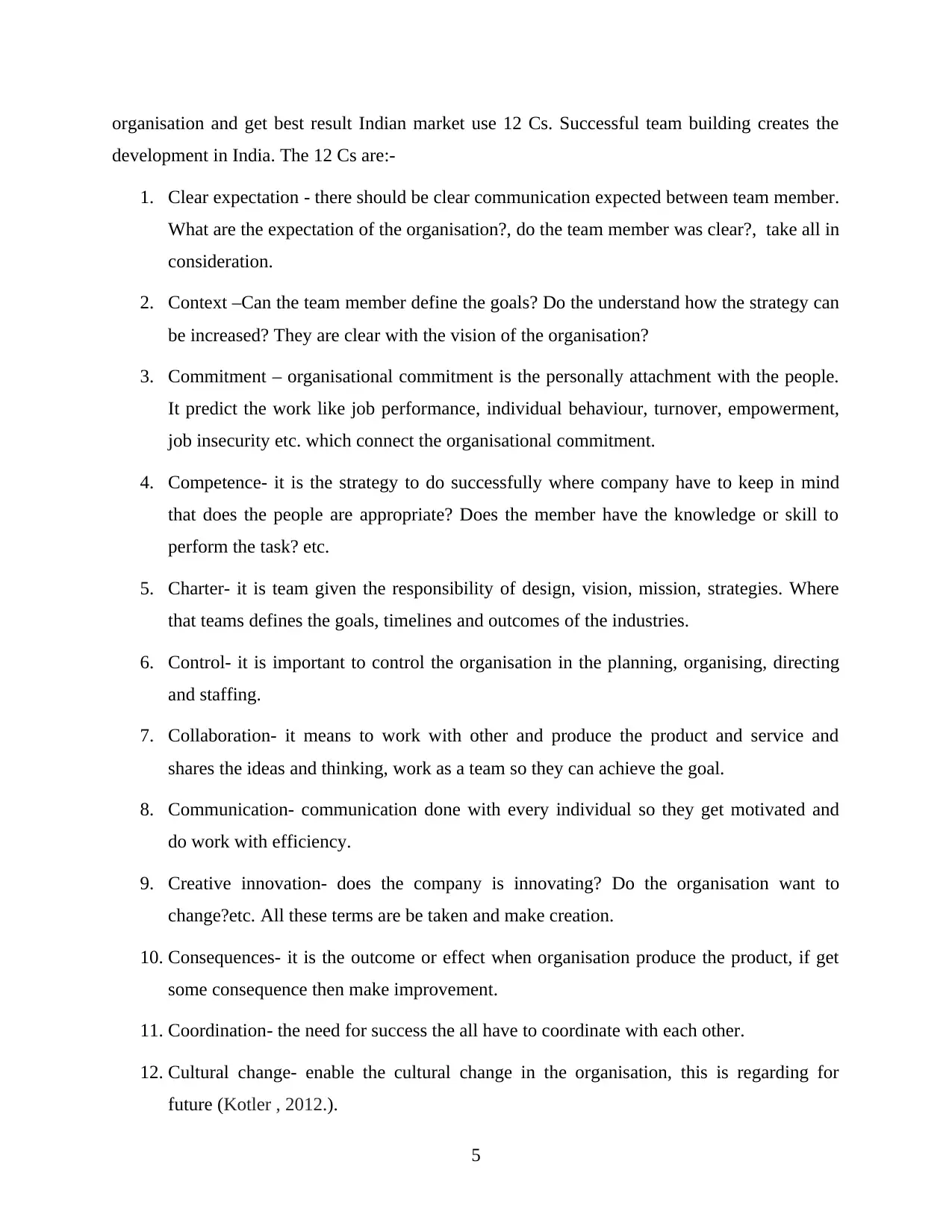
organisation and get best result Indian market use 12 Cs. Successful team building creates the
development in India. The 12 Cs are:-
1. Clear expectation - there should be clear communication expected between team member.
What are the expectation of the organisation?, do the team member was clear?, take all in
consideration.
2. Context –Can the team member define the goals? Do the understand how the strategy can
be increased? They are clear with the vision of the organisation?
3. Commitment – organisational commitment is the personally attachment with the people.
It predict the work like job performance, individual behaviour, turnover, empowerment,
job insecurity etc. which connect the organisational commitment.
4. Competence- it is the strategy to do successfully where company have to keep in mind
that does the people are appropriate? Does the member have the knowledge or skill to
perform the task? etc.
5. Charter- it is team given the responsibility of design, vision, mission, strategies. Where
that teams defines the goals, timelines and outcomes of the industries.
6. Control- it is important to control the organisation in the planning, organising, directing
and staffing.
7. Collaboration- it means to work with other and produce the product and service and
shares the ideas and thinking, work as a team so they can achieve the goal.
8. Communication- communication done with every individual so they get motivated and
do work with efficiency.
9. Creative innovation- does the company is innovating? Do the organisation want to
change?etc. All these terms are be taken and make creation.
10. Consequences- it is the outcome or effect when organisation produce the product, if get
some consequence then make improvement.
11. Coordination- the need for success the all have to coordinate with each other.
12. Cultural change- enable the cultural change in the organisation, this is regarding for
future (Kotler , 2012.).
5
development in India. The 12 Cs are:-
1. Clear expectation - there should be clear communication expected between team member.
What are the expectation of the organisation?, do the team member was clear?, take all in
consideration.
2. Context –Can the team member define the goals? Do the understand how the strategy can
be increased? They are clear with the vision of the organisation?
3. Commitment – organisational commitment is the personally attachment with the people.
It predict the work like job performance, individual behaviour, turnover, empowerment,
job insecurity etc. which connect the organisational commitment.
4. Competence- it is the strategy to do successfully where company have to keep in mind
that does the people are appropriate? Does the member have the knowledge or skill to
perform the task? etc.
5. Charter- it is team given the responsibility of design, vision, mission, strategies. Where
that teams defines the goals, timelines and outcomes of the industries.
6. Control- it is important to control the organisation in the planning, organising, directing
and staffing.
7. Collaboration- it means to work with other and produce the product and service and
shares the ideas and thinking, work as a team so they can achieve the goal.
8. Communication- communication done with every individual so they get motivated and
do work with efficiency.
9. Creative innovation- does the company is innovating? Do the organisation want to
change?etc. All these terms are be taken and make creation.
10. Consequences- it is the outcome or effect when organisation produce the product, if get
some consequence then make improvement.
11. Coordination- the need for success the all have to coordinate with each other.
12. Cultural change- enable the cultural change in the organisation, this is regarding for
future (Kotler , 2012.).
5
Paraphrase This Document
Need a fresh take? Get an instant paraphrase of this document with our AI Paraphraser
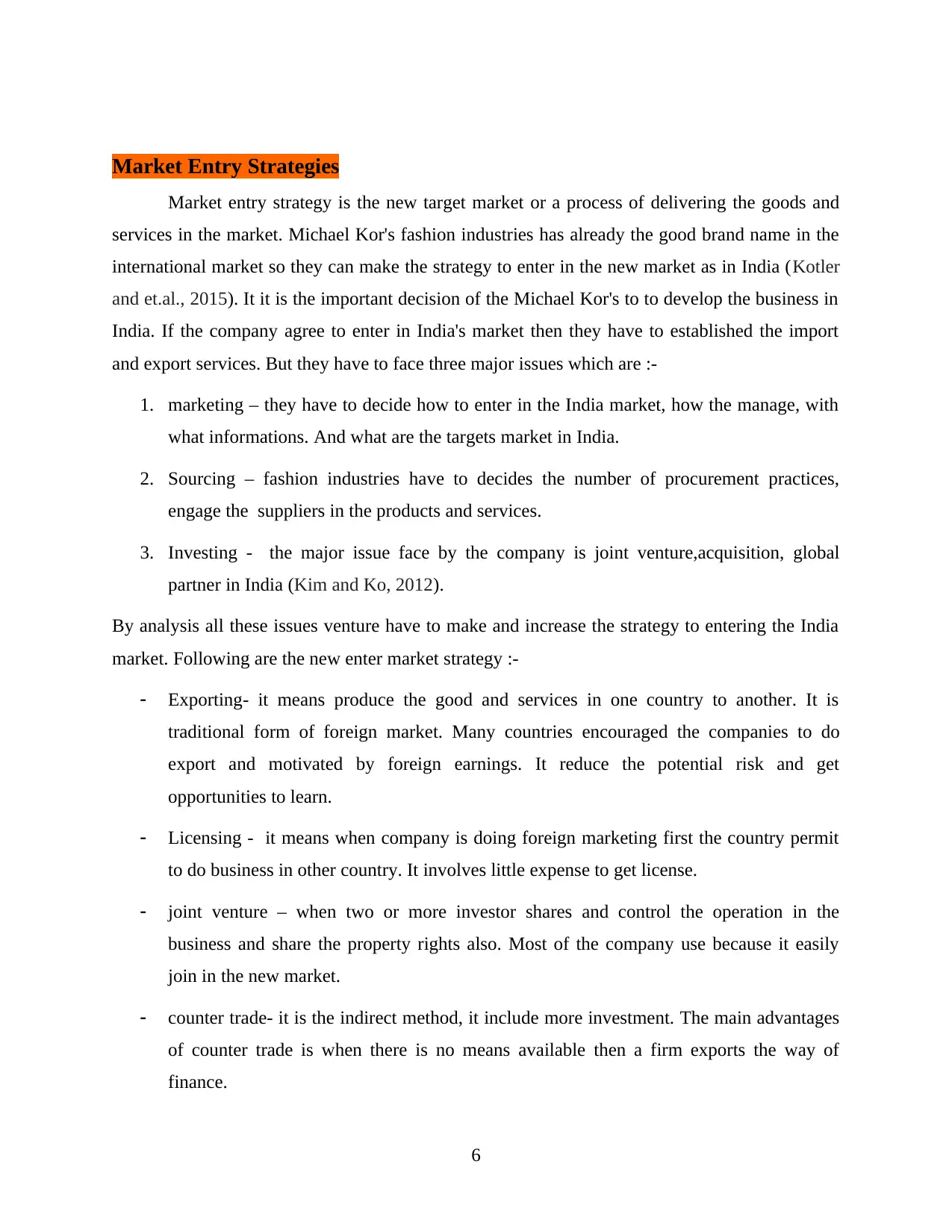
Market Entry Strategies
Market entry strategy is the new target market or a process of delivering the goods and
services in the market. Michael Kor's fashion industries has already the good brand name in the
international market so they can make the strategy to enter in the new market as in India (Kotler
and et.al., 2015). It it is the important decision of the Michael Kor's to to develop the business in
India. If the company agree to enter in India's market then they have to established the import
and export services. But they have to face three major issues which are :-
1. marketing – they have to decide how to enter in the India market, how the manage, with
what informations. And what are the targets market in India.
2. Sourcing – fashion industries have to decides the number of procurement practices,
engage the suppliers in the products and services.
3. Investing - the major issue face by the company is joint venture,acquisition, global
partner in India (Kim and Ko, 2012).
By analysis all these issues venture have to make and increase the strategy to entering the India
market. Following are the new enter market strategy :-
Exporting- it means produce the good and services in one country to another. It is
traditional form of foreign market. Many countries encouraged the companies to do
export and motivated by foreign earnings. It reduce the potential risk and get
opportunities to learn.
Licensing - it means when company is doing foreign marketing first the country permit
to do business in other country. It involves little expense to get license.
joint venture – when two or more investor shares and control the operation in the
business and share the property rights also. Most of the company use because it easily
join in the new market.
counter trade- it is the indirect method, it include more investment. The main advantages
of counter trade is when there is no means available then a firm exports the way of
finance.
6
Market entry strategy is the new target market or a process of delivering the goods and
services in the market. Michael Kor's fashion industries has already the good brand name in the
international market so they can make the strategy to enter in the new market as in India (Kotler
and et.al., 2015). It it is the important decision of the Michael Kor's to to develop the business in
India. If the company agree to enter in India's market then they have to established the import
and export services. But they have to face three major issues which are :-
1. marketing – they have to decide how to enter in the India market, how the manage, with
what informations. And what are the targets market in India.
2. Sourcing – fashion industries have to decides the number of procurement practices,
engage the suppliers in the products and services.
3. Investing - the major issue face by the company is joint venture,acquisition, global
partner in India (Kim and Ko, 2012).
By analysis all these issues venture have to make and increase the strategy to entering the India
market. Following are the new enter market strategy :-
Exporting- it means produce the good and services in one country to another. It is
traditional form of foreign market. Many countries encouraged the companies to do
export and motivated by foreign earnings. It reduce the potential risk and get
opportunities to learn.
Licensing - it means when company is doing foreign marketing first the country permit
to do business in other country. It involves little expense to get license.
joint venture – when two or more investor shares and control the operation in the
business and share the property rights also. Most of the company use because it easily
join in the new market.
counter trade- it is the indirect method, it include more investment. The main advantages
of counter trade is when there is no means available then a firm exports the way of
finance.
6
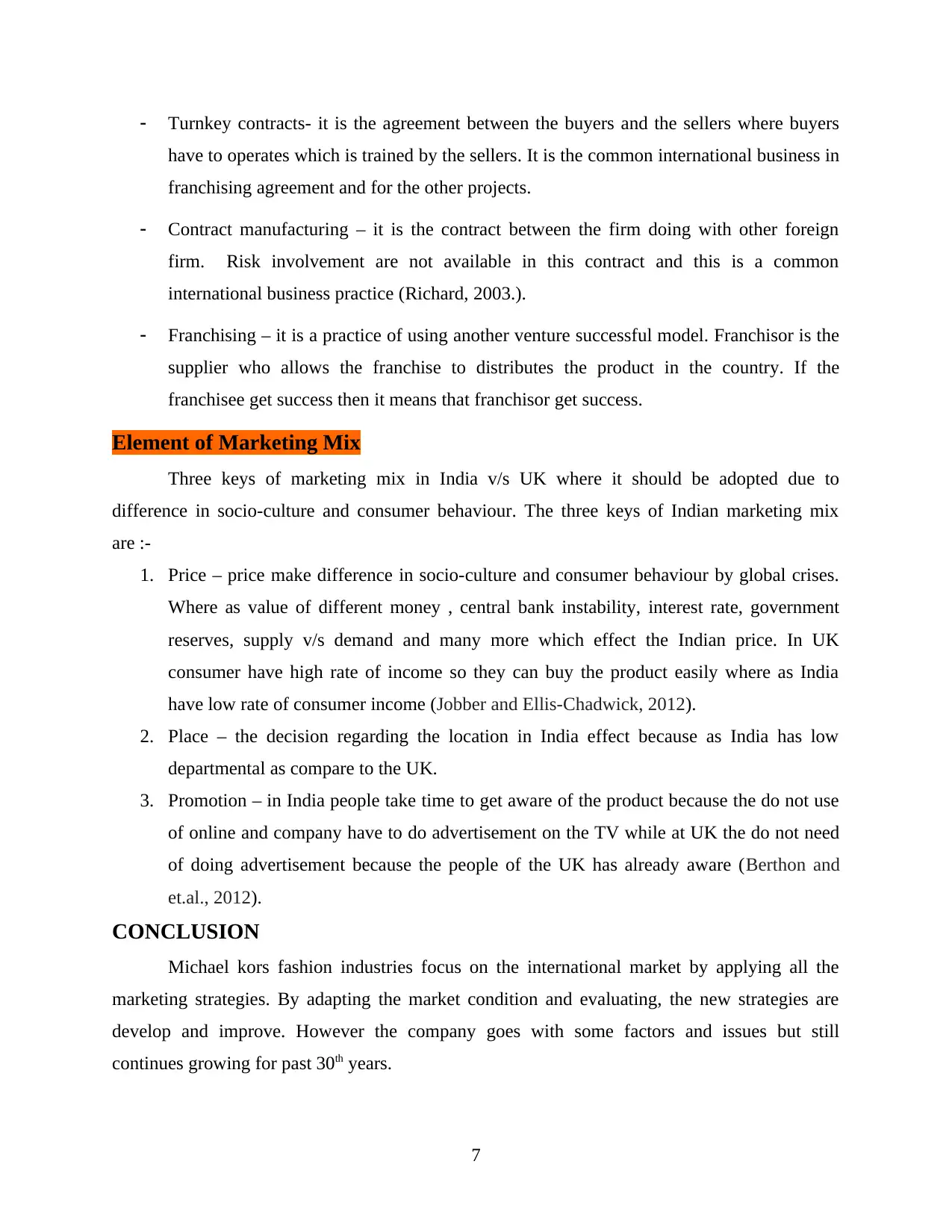
Turnkey contracts- it is the agreement between the buyers and the sellers where buyers
have to operates which is trained by the sellers. It is the common international business in
franchising agreement and for the other projects.
Contract manufacturing – it is the contract between the firm doing with other foreign
firm. Risk involvement are not available in this contract and this is a common
international business practice (Richard, 2003.).
Franchising – it is a practice of using another venture successful model. Franchisor is the
supplier who allows the franchise to distributes the product in the country. If the
franchisee get success then it means that franchisor get success.
Element of Marketing Mix
Three keys of marketing mix in India v/s UK where it should be adopted due to
difference in socio-culture and consumer behaviour. The three keys of Indian marketing mix
are :-
1. Price – price make difference in socio-culture and consumer behaviour by global crises.
Where as value of different money , central bank instability, interest rate, government
reserves, supply v/s demand and many more which effect the Indian price. In UK
consumer have high rate of income so they can buy the product easily where as India
have low rate of consumer income (Jobber and Ellis-Chadwick, 2012).
2. Place – the decision regarding the location in India effect because as India has low
departmental as compare to the UK.
3. Promotion – in India people take time to get aware of the product because the do not use
of online and company have to do advertisement on the TV while at UK the do not need
of doing advertisement because the people of the UK has already aware (Berthon and
et.al., 2012).
CONCLUSION
Michael kors fashion industries focus on the international market by applying all the
marketing strategies. By adapting the market condition and evaluating, the new strategies are
develop and improve. However the company goes with some factors and issues but still
continues growing for past 30th years.
7
have to operates which is trained by the sellers. It is the common international business in
franchising agreement and for the other projects.
Contract manufacturing – it is the contract between the firm doing with other foreign
firm. Risk involvement are not available in this contract and this is a common
international business practice (Richard, 2003.).
Franchising – it is a practice of using another venture successful model. Franchisor is the
supplier who allows the franchise to distributes the product in the country. If the
franchisee get success then it means that franchisor get success.
Element of Marketing Mix
Three keys of marketing mix in India v/s UK where it should be adopted due to
difference in socio-culture and consumer behaviour. The three keys of Indian marketing mix
are :-
1. Price – price make difference in socio-culture and consumer behaviour by global crises.
Where as value of different money , central bank instability, interest rate, government
reserves, supply v/s demand and many more which effect the Indian price. In UK
consumer have high rate of income so they can buy the product easily where as India
have low rate of consumer income (Jobber and Ellis-Chadwick, 2012).
2. Place – the decision regarding the location in India effect because as India has low
departmental as compare to the UK.
3. Promotion – in India people take time to get aware of the product because the do not use
of online and company have to do advertisement on the TV while at UK the do not need
of doing advertisement because the people of the UK has already aware (Berthon and
et.al., 2012).
CONCLUSION
Michael kors fashion industries focus on the international market by applying all the
marketing strategies. By adapting the market condition and evaluating, the new strategies are
develop and improve. However the company goes with some factors and issues but still
continues growing for past 30th years.
7
⊘ This is a preview!⊘
Do you want full access?
Subscribe today to unlock all pages.

Trusted by 1+ million students worldwide
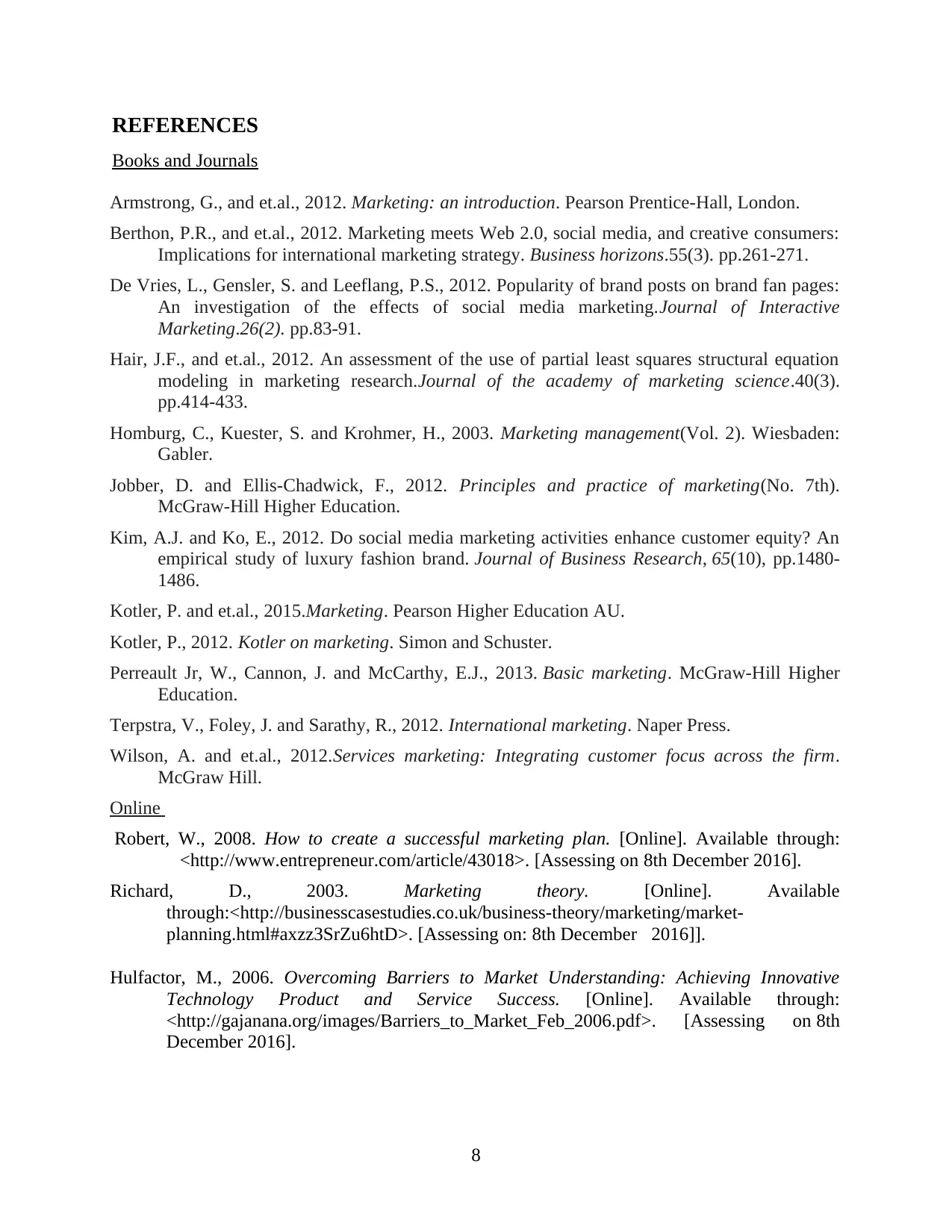
REFERENCES
Books and Journals
Armstrong, G., and et.al., 2012. Marketing: an introduction. Pearson Prentice-Hall, London.
Berthon, P.R., and et.al., 2012. Marketing meets Web 2.0, social media, and creative consumers:
Implications for international marketing strategy. Business horizons.55(3). pp.261-271.
De Vries, L., Gensler, S. and Leeflang, P.S., 2012. Popularity of brand posts on brand fan pages:
An investigation of the effects of social media marketing.Journal of Interactive
Marketing.26(2). pp.83-91.
Hair, J.F., and et.al., 2012. An assessment of the use of partial least squares structural equation
modeling in marketing research.Journal of the academy of marketing science.40(3).
pp.414-433.
Homburg, C., Kuester, S. and Krohmer, H., 2003. Marketing management(Vol. 2). Wiesbaden:
Gabler.
Jobber, D. and Ellis-Chadwick, F., 2012. Principles and practice of marketing(No. 7th).
McGraw-Hill Higher Education.
Kim, A.J. and Ko, E., 2012. Do social media marketing activities enhance customer equity? An
empirical study of luxury fashion brand. Journal of Business Research, 65(10), pp.1480-
1486.
Kotler, P. and et.al., 2015.Marketing. Pearson Higher Education AU.
Kotler, P., 2012. Kotler on marketing. Simon and Schuster.
Perreault Jr, W., Cannon, J. and McCarthy, E.J., 2013. Basic marketing. McGraw-Hill Higher
Education.
Terpstra, V., Foley, J. and Sarathy, R., 2012. International marketing. Naper Press.
Wilson, A. and et.al., 2012.Services marketing: Integrating customer focus across the firm.
McGraw Hill.
Online
Robert, W., 2008. How to create a successful marketing plan. [Online]. Available through:
<http://www.entrepreneur.com/article/43018>. [Assessing on 8th December 2016].
Richard, D., 2003. Marketing theory. [Online]. Available
through:<http://businesscasestudies.co.uk/business-theory/marketing/market-
planning.html#axzz3SrZu6htD>. [Assessing on: 8th December 2016]].
Hulfactor, M., 2006. Overcoming Barriers to Market Understanding: Achieving Innovative
Technology Product and Service Success. [Online]. Available through:
<http://gajanana.org/images/Barriers_to_Market_Feb_2006.pdf>. [Assessing on 8th
December 2016].
8
Books and Journals
Armstrong, G., and et.al., 2012. Marketing: an introduction. Pearson Prentice-Hall, London.
Berthon, P.R., and et.al., 2012. Marketing meets Web 2.0, social media, and creative consumers:
Implications for international marketing strategy. Business horizons.55(3). pp.261-271.
De Vries, L., Gensler, S. and Leeflang, P.S., 2012. Popularity of brand posts on brand fan pages:
An investigation of the effects of social media marketing.Journal of Interactive
Marketing.26(2). pp.83-91.
Hair, J.F., and et.al., 2012. An assessment of the use of partial least squares structural equation
modeling in marketing research.Journal of the academy of marketing science.40(3).
pp.414-433.
Homburg, C., Kuester, S. and Krohmer, H., 2003. Marketing management(Vol. 2). Wiesbaden:
Gabler.
Jobber, D. and Ellis-Chadwick, F., 2012. Principles and practice of marketing(No. 7th).
McGraw-Hill Higher Education.
Kim, A.J. and Ko, E., 2012. Do social media marketing activities enhance customer equity? An
empirical study of luxury fashion brand. Journal of Business Research, 65(10), pp.1480-
1486.
Kotler, P. and et.al., 2015.Marketing. Pearson Higher Education AU.
Kotler, P., 2012. Kotler on marketing. Simon and Schuster.
Perreault Jr, W., Cannon, J. and McCarthy, E.J., 2013. Basic marketing. McGraw-Hill Higher
Education.
Terpstra, V., Foley, J. and Sarathy, R., 2012. International marketing. Naper Press.
Wilson, A. and et.al., 2012.Services marketing: Integrating customer focus across the firm.
McGraw Hill.
Online
Robert, W., 2008. How to create a successful marketing plan. [Online]. Available through:
<http://www.entrepreneur.com/article/43018>. [Assessing on 8th December 2016].
Richard, D., 2003. Marketing theory. [Online]. Available
through:<http://businesscasestudies.co.uk/business-theory/marketing/market-
planning.html#axzz3SrZu6htD>. [Assessing on: 8th December 2016]].
Hulfactor, M., 2006. Overcoming Barriers to Market Understanding: Achieving Innovative
Technology Product and Service Success. [Online]. Available through:
<http://gajanana.org/images/Barriers_to_Market_Feb_2006.pdf>. [Assessing on 8th
December 2016].
8
1 out of 10
Related Documents
Your All-in-One AI-Powered Toolkit for Academic Success.
+13062052269
info@desklib.com
Available 24*7 on WhatsApp / Email
![[object Object]](/_next/static/media/star-bottom.7253800d.svg)
Unlock your academic potential
Copyright © 2020–2025 A2Z Services. All Rights Reserved. Developed and managed by ZUCOL.





